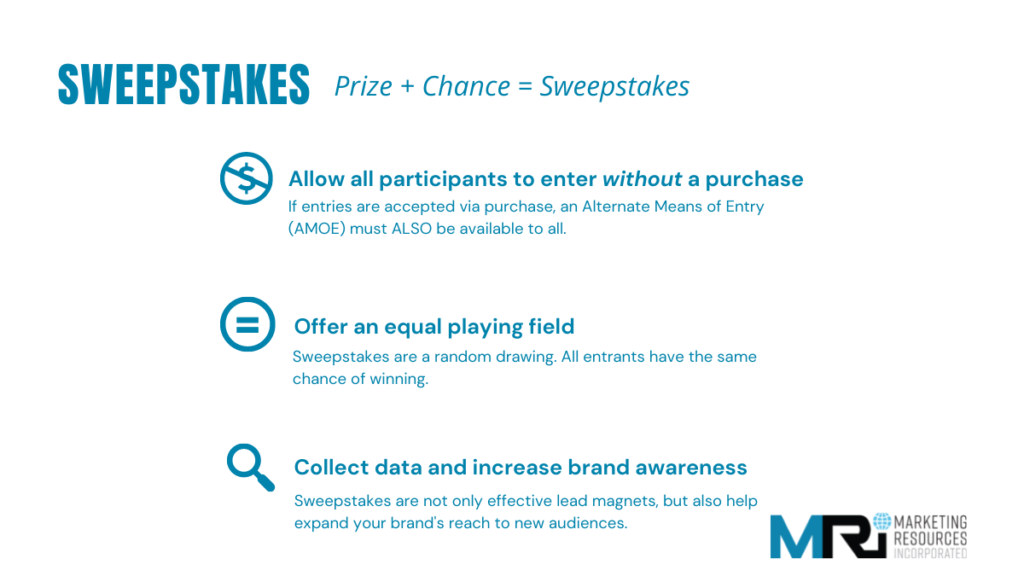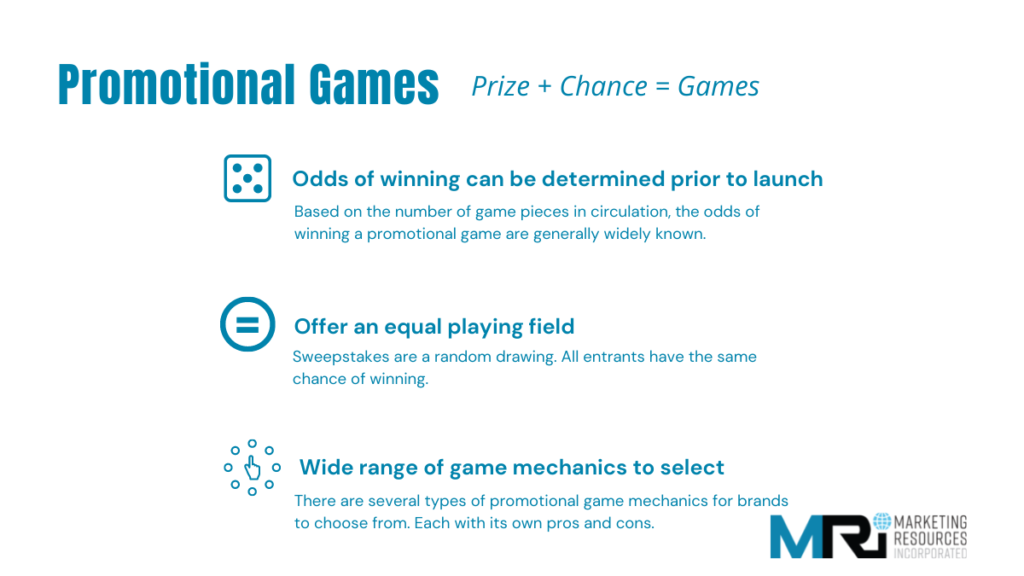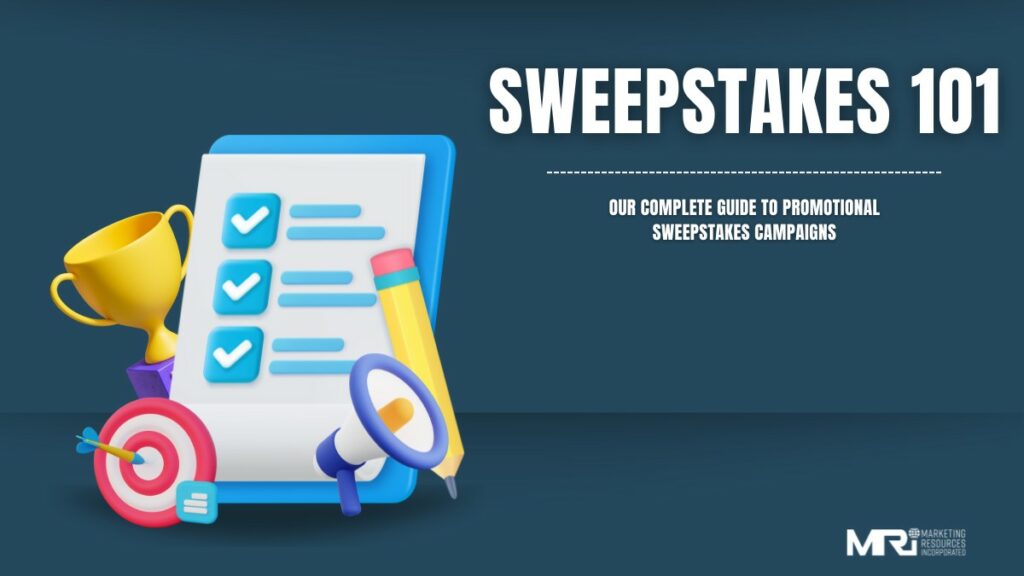The World of Promotional Marketing
Oftentimes mistakenly referred to as simply just a “sweepstakes,” the world of promotional marketing campaigns is actually far more expansive than only a sweepstakes campaign. In fact, sweepstakes, contests, promotional games, and giveaways are all effective campaigns that your brand can execute in order to support your overall marketing efforts. Knowing the differences between the different campaigns, their intricacies, and which type of promotional campaign to execute for your brand will help put your brand on top of the marketing world.
These promotions are not only lead magnets for brands, but they also delight customers, turning them into brand loyal consumers deeply connected to brands.
Prior to diving into the ins and outs of marketing promotions, having a foundational understanding of a “legal lottery” is critical. Lotteries are a centuries-old promotional tactic that feature three essential elements: a prize, an element of chance, and some sort of consideration.
What is a Legal Lottery? How Does My Brand Run A Legal Promotional Campaign?
Prize + Chance + Consideration = Legal Lottery
Prize:
The easiest of the three elements to define, is the prize. This is simply the promise of some sort of reward in exchange for participating in a promotion. Prizes can be awarded in a number of ways: as a cash prize, time spent with a celebrity, a physical gift, a vacation.. You name it!
Chance:
The element of chance is also a significant factor to consider when strategizing a marketing promotion. Here, a winner must be selected at random. No one applicant or participant should have an advantage over any of the other participants when determining a winner.
Consideration:
There are two types of “consideration” at play when planning a marketing promotion. The first is a monetary consideration, meaning participants must pay for the chance to win. Any payment or entry fee required to participate is technically a “consideration.” For example, if a contestant can “enter” a campaign with a code found inside the package of a product they’ve just purchased, the price they paid for the product is considered the “entry fee.”
Similarly, non-monetary considerations are relevant when a task is considered the barrier to entry, AND that task would benefit the promotion facilitator in some way. For example, a non-monetary consideration would be requiring an entrant to create a new logo for a brand in order to participate in a promotion.
When all three elements, prize, chance, and consideration, are included in a marketing promotion, it is known as a “lottery.” Currently, only the federal or state government can facilitate a lottery with all three essential elements. Anyone else looking to run a promotion (including your brand), must eliminate one of the three.
A common way around this that you’ve surely seen in practice is claiming “no purchase necessary to win” when announcing a promotion. This tactic clearly eliminates the element of consideration since it removes the monetary barrier to participate. Removing either chance or the prize will also suffice in ensuring your promotion remains legal (although, it probably won’t be a very well-received promotion if you remove the prize).
With this foundational knowledge in place, you have the basic information you need to execute your brand’s next promotional campaign. While the consequences of running an illegal lottery are severe (steep fines and criminal penalties), you can rest assured knowing a trusted sweepstakes administrator is on your team. For more information on how to pick the right partner, check out our blog or contact one of our experts today.
Currently, only the federal or state government can facilitate a lottery with all three essential elements, prize, chance, and consideration.
Sweepstakes

So, what is a sweepstakes? The most commonly recognized type of promotional campaign, a sweepstakes is, simply put, a random drawing. However, over the years, “sweepstakes” has served as an umbrella term for all of promotional marketing and its campaigns.
Of course, now that you understand the ins and outs of a legal lottery, differentiating between a sweepstakes, contest, and promotional game should be a walk in the park. Look at you, you smarty-pants!
For a sweepstakes campaign to be deemed legal, “consideration” needs to be eliminated from the mix, leaving prize and chance. This means that you cannot require payment or any amount of significant effort from all entrants. This does NOT disqualify your brand from accepting those types of entries though.
If your brand DOES accept sweepstakes entries that include some sort of “consideration” (like a unique code on a package) you must ALSO offer a “consideration-free” method of entry. This is officially known as an “Alternate Means of Entry” or “AMOE.”
A promotional sweepstakes, therefore, allows all participants to enter without a purchase ( and will most often include the language “NO PURCHASE NECESSARY.”). If there is a purchase requirement, an Alternate Means of Entry (“AMOE”) that doesn’t involve a purchase requirement must be made available to participants.
This alternate and free method must be clearly and conspicuously disclosed to all participants. Examples of AMOE include forms that must be filled out either by hand and mailed in, or filled out and submitted online.
Check out our full guide on how to plan your brand’s sweepstakes here.
Sweepstakes Offer an Equal Playing Field
Sweepstakes campaigns are unique in that every participant has the same exact opportunity to win. No single entry to a promotional sweepstakes campaign is more likely to win than any other entry.
Rather, sweepstakes are ruled entirely by chance. Sure, some individuals might submit a large number of entries to a sweepstakes campaign giving them a higher chance of winning, but each entry is weighed the same.
Why Brands Choose to Run a Sweepstakes
Perhaps the best selling point for a sweepstakes is its versatility. Brands may choose to run a sweepstakes to accomplish any number of goals. With the proper sweepstakes administrator on your side, your brand can breathe easy knowing your campaign aligns with your brand’s purpose.
All things considered, a sweepstakes campaign can be a simple solution to increasing consumer engagement with your brand. The best part: the data gathered from every sweepstakes will give you the information you need to make an even more successful sweepstakes next time.
Collecting Data
Understanding consumer behavior is critical for fostering brand loyalty. From consumer information (names, emails, addresses, etc.), to data on your brand, sweepstakes offer brands invaluable data about their consumers.
Sweepstakes entries provide brands with the consumer information they need to grow their audience and meet their lead generation goals. Similarly, brands can further analyze the data from their sweepstakes to better understand consumer preferences and behavior. Brands can take a look a which prizes were most popular, which regions had the most engagement, which retail locations sold the most products, and so on in order to gain insight into their fans.
Increase Brand Awareness and Retail Sales
Consumers aren’t the only ones that can win with a sweepstakes. Gamification in marketing can be a fun way to promote your brand. With a sweepstakes, brands can promote specific products by tying entries to the purchase of said product.
Similarly, brands can accept social media engagement as an entry to a sweepstakes, boosting their brand awareness and overall reach online.
Promotional Games

Similar to sweepstakes, in order for a promotional game to be deemed legal, “consideration” needs to be eliminated from the mix, leaving prize and chance. But wait, that sounds exactly like a sweepstakes, so what gives?
Well, since you asked, the main differentiation between a game and a sweepstakes is that in a game, odds can generally be determined prior to the promotion launch based on a set number of physical game pieces being produced/prizes being distributed into the market.
For example, a brand may decide to run an instant-win game, offering free food based on the code underneath a peel-off tab on its cups. This brand will know before the program launches exactly how many peel-off tabs they’ll place on cups, and exactly what quantity of each prize will be awarded. They have to.. since they’ll need to get these items printed and distributed to their restaurants. Of course, they can always add more as a promotion is active, but the main point is that they always know exactly how many game pieces are in play.
An exception to this would be an online instant win game, the odds would then be based on eligible entries received and the time in which they were received versus a defined set of odds since the number of participants can’t be clearly defined.
Now, there are different types of promotional games a brand can choose to run. Game examples include instant win, collect and win, match and win, or peel and win.
An AMOE must be available for participants if there is a purchase requirement for the promotion so consideration isn’t brought back into the mix.
Types of Promotional Games
Instant Win
The best of Instant win programs is that they do, well, just that…tell somebody they are the winner, right then and there– instantly. Immediate gratification is a great way to inspire repeat action for your consumers
Seriously, everybody loves to win. There’s no better feeling than picking up your favorite product, opening up a bottle, and seeing that you won. Or another example, going online, entering in your information, and immediately seeing you’re a winner.
When might you want to execute an instant-win game over a different type of game?
As a brand, when you want to encourage repeat activity – engagement, purpose, or exposure – this is when we consider instant-win games to be highly effective. We’ll work that into the goals we’re looking to achieve for the brand, help to set up the program, and offer the best experience for the consumer.
Now when we look at a few different ways to run an Instant Win, we can start to get into the different mechanics and methods to win.
Match and Win
Similar to hitting triple 7’s on the slot machine, you can have a lot of fun asking consumers to find and match items.
Whether you want to execute this physically in person, or virtually and on the digital side of things, a match and win game is sure to excite.
Collect and Win
An incredibly common promotional game mechanic, collect and win games simply require participants to collect a certain amount of game pieces in exchange for a prize. You’ve probably seen this done before with a popular board game and even more popular fast food restaurant, but that is just one of many examples out there.
Collect and win games excite players over a period of time, encouraging them to come back and re-engage with your brand time and time again in order to win their coveted prize.
Peel and Win
This IW mechanic is more physical with the active peeling away of a game piece. We can get into the production aspect, and the great part here is that you have the tactile experience from your consumers holding a game piece in their hand. And when you have the physical game piece, you can offer up on-the-spot redemption which works really well for quick-service or foodservice accounts. MRi ran the Raising Cane’s One Love
Keep in mind that many of these mechanics can be combined to create one custom game for your brand. For example, participants may need to collect game pieces that they peel off of a cup to win.
Whatever your brand’s goals, a promotional marketing expert at MRi will help you identify your purpose and execute a campaign that will reach them.
Contest/Skills Contest

Moving on to promotional contests now, in order for these to be deemed legal “chance” needs to be eliminated from the mix, leaving prize and consideration. Contests should not be randomized.
Since a promotional contest eliminates the element of chance, a purchase may be required for participation (excluding AZ, NJ, ND, TN, and VT; these states do not allow contests to be run that require payment for entry). It would be totally legal to require entrants to pay a fee in order to participate in your contest. Keep in mind though that a financial consideration will be a barrier to entry and may limit the number of entries you receive.
Unlike sweepstakes or games which are ruled by chance, contests rely on some sort of skill to determine a winner. While there is no clearly defined definition of “skill,” a good guideline is that a contest cannot be so difficult that it is impossible to win. However, this doesn’t necessarily mean that every contest must have a winner, it just means that it must be reasonably possible.
Chicagoans may remember the infamous Goose Island Field Goal Kicking contest where, predictably, every single contest missed the 43-yeard field goal they themselves claimed would be so easy to hit. Nobody was able to successfully “win” this contest, but it was certainly not impossible.
First kicker, who got here 5 hours before the event, starts with this.. it’s going to be a long day pic.twitter.com/7tjLuSuH0u
— Madeline Kenney (@madkenney) January 12, 2019
Legal contest examples can include photography, recipe, or essay contests. Basically, anything that is judged on a certain, pre-defined set of criteria. Since “the best” is incredibly subjective, consider being very specific in regards to how the contest will be judged or scored.
Be careful with promotional contests as some illegal contest examples are actually quite common! These dubiously illegal games include things guessing games like the number of jelly beans in a jar, spotting a mystery shopper, or accumulating the most proofs of purchase since this brings “chance” back into the mix.
Skill must determine and control the final results of winner selection for a contest. If there is a tie at the end of the program, a random drawing cannot be conducted because that would bring chance back into the equation. If you have two finalists who are totally equal, you cannot simply flip a coin in order to see who wins. Be prepared for every scenario and have a backup plan to determine a winner (again, based on skill) before you launch. Means of determining the outcome in tiebreakers must be defined in the official rules prior to the promotion running.
Benefits of Running a Promotional Contest
Other than just being fun and engaging, there are several strong business cases brands may make when choosing to run a promotional contest.
Contests are great tools for collecting user-generated content that can support your brand’s marketing efforts down the road. For example, brands that choose to run a contest via social media requiring fans to share a picture with their product, that brand has just given themselves a ton of new pictures to use across social media and in advertisements.
When it comes to generating leads, contests tend to generate higher-intent leads. This is due to the fact that contests usually have greater barriers to entry than say a sweepstakes or a promotional game. Participants actually have to expend a fair amount of time or effort to enter a contest. This usually results in greater levels of engagement and a deeper connection with the brand.
6 Steps to Plan Your Brand’s Promotional Campaign
Congratulations! Now that you can successfully identify a legal lottery AND differentiate between the three main types of promotional campaigns, it’s officially time to begin planning your brand’s strategy.
As with any marketing strategy, planning your brand’s promotional campaign requires a fair amount of research, time, and effort. Don’t let that discourage you though. Instead, delegate some (or all) of your promotional planning to a trusted, award-winning partner like Marketing Resources Inc. for a stress-free fast pass to all the benefits a promotional campaign has to offer.
Feel more like a do-it-yourselfer? We love that! Below is our general 6-step planning process, refined over 25 years of successfully administering hundreds of promotional campaigns.
Step 1: Develop appropriate marketing goals. Avoid organizational silos and be sure that your marketing goals align with your overall business goals. Consider following the SMART process for setting specific, measurable, attainable, relevant, and time-based goals.
Some examples include:
- Contemporize your brand to keep up with the latest trends
- Generate a sales lift
- Gain incremental off-shelf opportunities at retail
- Increase traffic to a website
- Gather consumer information for future marketing initiatives
- Support a new product launch
Step 2: Determine or collect the following information. You may need to reach outside of your own department for some of these, so ensure all stakeholders agree:
- Your brand personality- will you be professional? Funny? Helpful? What tone of voice will you use?
- Target audience- who are they? What are their interests? How do they find your brand (or brands like yours?). How will you reach them?
- Competitor audit- what are your competitors doing? What works for them? What doesn’t work for them? Look into conducting a SWOT analysis to determine your brand’s strengths, weaknesses, opportunities, and threats.
- Timing- When is the best time to run a promotional campaign? Is there a time of year that your business needs a boost? Do you have seasonal or limited-time offers that you want to promote?
- Holiday opportunities
- Major events
- Product selling cycle
- Budgets- How much money does your brand have to spend executing a promotional campaign? Is this a priority for you, or does your brand have a surplus budget to use up?
- Concept development
- Creative development
- Prize pool
- Advertising
- Production elements (game pieces, tear pads, POP displays, etc.)
- Program administration and fulfillment
Step 3: Concept Development and Programm Outline- Determine which type of promotional campaign you will execute in order to meet your brand’s goals: Some types of programs to consider include:
- Sweepstakes
- Contests
- Instant Win
- Advergame
- Collect ‘n Win
- Trivia games
- Loyalty Programs
Step 4: Design creative elements- Consider the creative assets you’ll need to effectively market your promotion. Website graphics, social graphics, print media, even in-store signage may be necessary elements of your brand’s next promotional campaign.
Step 5: Hire MRI to administer your program… it’s often a good idea to hire MRI at the outset of the program to assist with any questions you may have along the way. Our full-service, consultative approach blends consumer insights, promotional expertise in the marketplace, and past experiences to Identify your promotion’s unique purpose, creating a stronger, more emotional connection with your consumers. A full-service firm, we pride ourselves on managing each aspect of a promotional campaign, including:
- Advise with game mechanics
- Legal – Rules development
- Fulfillment – Winner notification and verification
- Sweepstakes drawings
- Micro-site development and hosting
- Prize procurement
- Game piece production
- POP/POS production and management
Step 6: Enjoy the fruits of your labor! Planning a promotion can seem like a tedious process. But with the proper planning and proven vendor partners, it can be a wonderfully rewarding experience for both the consumer and the brand.
Hiring a Sweepstakes Administrator
With this solid foundational knowledge of sweepstakes and promotional campaigns, your brand is ready to begin executing them and reaping their rewards. The final step? Hiring the right partner for your brand.
At MRi, we have decades of experience helping brands identify their purpose and execute successful campaigns through our unique IDEA approach. No matter where you are in your promotional campaign planning, contact us today to run your brand’s next successful campaign!





